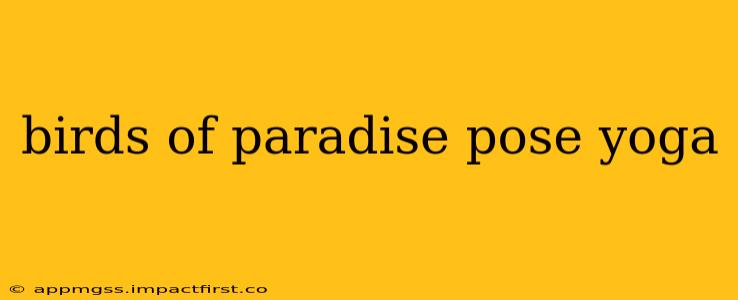The Birds of Paradise Pose, or Natarajasana, is a challenging yet rewarding yoga asana that improves balance, strength, and flexibility. It's a beautiful and dynamic pose, often admired for its elegance and the graceful extension it demands. This comprehensive guide will delve into the intricacies of this pose, addressing common questions and offering modifications for various skill levels.
What are the benefits of Birds of Paradise Pose?
The Birds of Paradise Pose offers a multitude of benefits, impacting both physical and mental well-being. Physically, it strengthens the legs, ankles, and core, while simultaneously improving balance and coordination. The backbend opens the chest and shoulders, improving posture and promoting deeper breathing. The pose also stretches the hips, groin, and thighs. Mentally, this pose fosters focus and concentration, requiring a significant level of body awareness and control. The sense of accomplishment after successfully holding the pose can boost self-esteem and confidence.
How do I do Birds of Paradise Pose?
While the pose looks elegant, it requires careful execution to avoid injury. Here's a step-by-step guide:
-
Start in Tadasana (Mountain Pose): Ground yourself, feeling stable and centered.
-
Bend your right knee: Bring your right foot towards your inner right thigh, keeping your knee aligned with your ankle.
-
Grab your right foot: Reach back and grasp your right foot with your right hand, keeping your knee bent.
-
Extend your left leg: Straighten your left leg, extending it behind you and engaging your leg muscles.
-
Lift your right knee: Carefully lift your right knee towards the ceiling, engaging your core muscles.
-
Extend your torso: Extend your upper body forward, keeping your gaze focused forward.
-
Maintain your balance: Engage your core muscles and focus on your breath to maintain balance.
-
Hold the pose: Hold for a few breaths, gradually increasing the hold time as your strength and balance improve.
-
Release and repeat: Gently release the pose and repeat on the other side.
Is Birds of Paradise Pose the same as Natarajasana?
Yes, Birds of Paradise Pose and Natarajasana are the same yoga pose. The name "Birds of Paradise" is a more evocative and accessible name used in some yoga studios to describe this elegant backbend, likely referencing the visual similarity to the bird's graceful posture.
How can I modify Birds of Paradise Pose for beginners?
For beginners, the full expression of Birds of Paradise Pose can be challenging. Several modifications can make it more accessible:
-
Use a chair: Place a chair behind you for support. Lean against the chair as you reach back for your foot and lift your knee.
-
Hold onto a wall: Stand facing a wall and use the wall for balance as you execute the pose.
-
Keep your back straight: Focus on keeping your back straight to avoid over-arching.
-
Start with shorter holds: Hold the pose for only a few seconds initially, gradually increasing the hold time as you gain strength and balance.
-
Use a strap: If you cannot reach your foot comfortably, use a yoga strap to assist you.
What are some common mistakes to avoid in Birds of Paradise Pose?
Several common mistakes can hinder your progress and potentially lead to injury:
-
Over-arching your back: This can strain your spine. Focus on lengthening your spine and engaging your core.
-
Looking down: Looking down compromises balance. Keep your gaze focused forward.
-
Lifting your knee too high: Lifting your knee too high before lengthening your torso can cause imbalance and strain.
-
Not engaging your core: Core engagement is crucial for stability and balance.
-
Forcing the pose: Never force the pose. Listen to your body and respect your limitations.
How long should I hold Birds of Paradise Pose?
The ideal hold time for Birds of Paradise Pose depends on your individual fitness level and experience. Beginners may hold the pose for a few seconds, while more experienced practitioners can hold it for longer periods, aiming for 30 seconds to a minute per side. Always prioritize proper form over length of hold.
Mastering Birds of Paradise Pose requires patience, dedication, and a mindful approach. By following these guidelines and respecting your body's limitations, you can safely and effectively incorporate this beautiful and challenging pose into your yoga practice. Remember to listen to your body and adjust as needed. Enjoy the journey!
